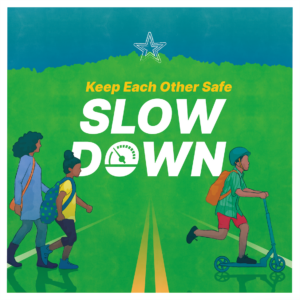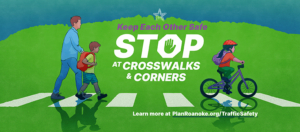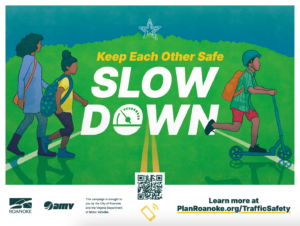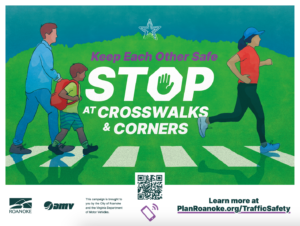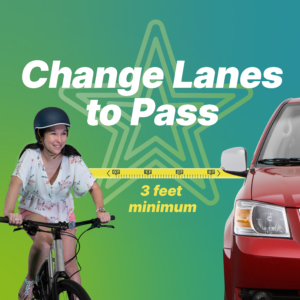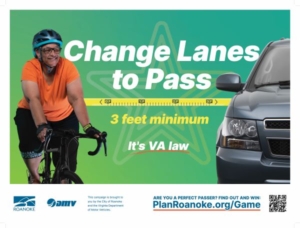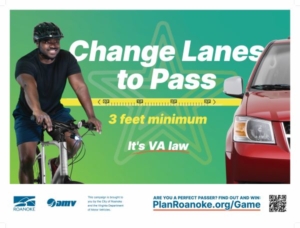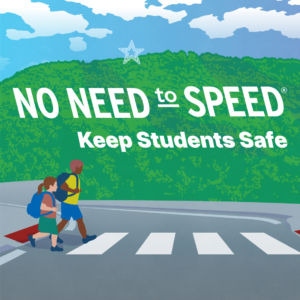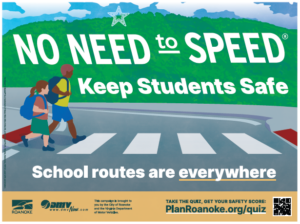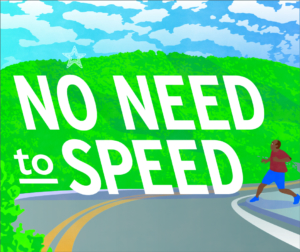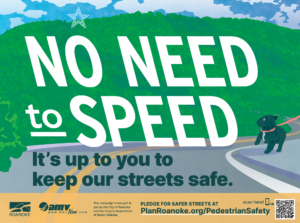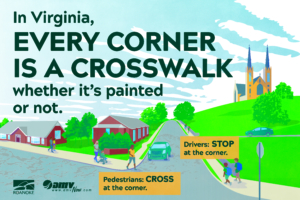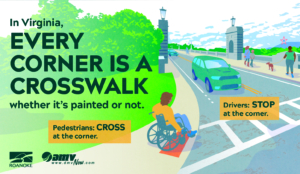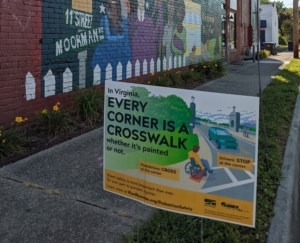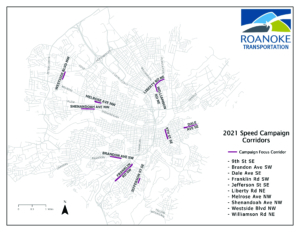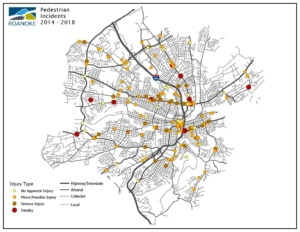Together we can keep each other safe
Every year, too many pedestrians are involved in crashes or close calls with cars. Walking and biking in Roanoke should be safe, not scary. Drivers slowing down and stopping at crosswalks and corners leads to fewer crashes, fewer injuries, and fewer deaths. To help keep each other safe, the City of Roanoke launched a traffic safety campaign on June 10, 2024 to help reduce the number of pedestrians involved in crashes by increasing driver adherence to crosswalk laws and speed limits.
The campaign wrapped up on July 21. Thank you to everyone who participated, and to the nearly 200 people who ordered yard signs!
Use the menu to the left to learn more about the campaign, read our blog series, and see below for ways you can still get involved.
Get Involved
- Order Materials: Campaign yard signs and posters are available to pick-up through our online form.
- Stay in the Loop: Sign up for our email list for updates and visit our website for timely traffic safety education.
Keep Each Other Safe Campaign Materials
Change Lanes to Pass Campaign Materials
School Zone Safety Campaign Materials
No Need to Speed Campaign Materials
Every Corner is a Crosswalk Campaign Materials
Keep Each Other Safe Campaign Details
Change Lanes to Pass Campaign Details
School Zone Safety Campaign Details
No Need to Speed Campaign Details
Every Corner is a Crosswalk Campaign Details
For Drivers
Traffic Speed Laws
A speed limit is the maximum legal speed you can travel on a road under ideal conditions. You may drive slower than the speed limit, if you don’t impede the normal movement of traffic, but it is illegal to drive any faster.
The maximum speed limit is fifteen miles per hour in most school zones in the City of Roanoke. Drivers may receive a fine of up to $250 if they exceed the speed limit in a school zone. VA Code 46.2-873. Learn more here.
Crosswalk Law for Drivers
Virginia law requires people driving to stop for pedestrians in the crosswalk, whether it is painted or not. Drivers may be more familiar with painted crosswalks, but they should know that every intersection (or corner) is a crosswalk whether it is painted or not. VA Code 46.2-926
Careless Driving Law
Virginia law prohibits driving in a careless or distracted way that causes serious bodily injury to a vulnerable road user (such as a pedestrian). Drivers may receive a fine of up to $2,500 and one year in county jail for committing careless driving that injures a vulnerable road user. VA Code 46.2-816.1
Hands Free Law
Virginia law prohibits using any handheld communication device while driving. Drivers may receive a fine of $125 for a first offense, and a fine of $250 for a second for subsequent offense. VA Code 46.2-1078.1.
3 Feet & Passing Law
Virginia law states that drivers passing bicyclists traveling in the same direction must allow a minimum of 3 feet of space between their vehicle and the bicyclist. If the travel lane is not wide enough to allow this, the driver must change lanes. VA Code 46.2-839.
Virginia law also states that drivers shall cross a double yellow line in order to give a bicyclist at least 3 feet of space when passing. VA Code 46.2-804.
After passing, the driver shall return to the right side of the road only once clear of the passed bicycle. VA Code 46.2-839. Learn more here.
How People Driving Can Prevent Crashes:
Obey the speed limit
- Travel the speed limit and at safe speeds for roadway conditions
- Follow slower speed limits in school zones, neighborhoods, and parks
Be aware
- Be aware of your surroundings and always on the lookout for pedestrians (especially children) on the side of the street. Be prepared to slow down and stop should a pedestrian step into the road.
Look for people crossing the street before turning right or left
- Before turning right or left, look for pedestrians and stop for them.
- When turning right on red, come to a complete stop and scan for pedestrians. Only proceed when it is clear.
Stop for pedestrians at all crosswalks, and remember some crosswalks are not painted
- When in doubt, consider that just about every corner in Virginia is a crosswalk. While some crosswalks are painted, many are not.
- Stop for pedestrians who have a “Walk” signal and anyone in a crosswalk. Drivers must stop even if the pedestrian is crossing once the “Walk” signal has expired.
Change lanes to pass bicyclists
- When approaching a bicyclist (whether they are riding on the road, shoulder, or bike lane) slow down, wait until there is no oncoming traffic, then change lanes to pass, allowing at least 3 feet of space between your car and the bicycle.
- Return to your lane only once you’re clear of the passed bicycle.
- Change lanes even if a bike lane is present.
For Pedestrians
Crosswalk Laws for Pedestrians
Virginia law says that pedestrians have the right of way in crosswalks and at intersections. However, the law also says that pedestrians should never step into the crosswalk (painted or not) if there is not enough time for a driver to stop. While painted crosswalks are easy to see, unmarked crosswalks are not. Unmarked crosswalks exist wherever streets intersect, at the corners of the street. VA Code 46.2-924
How people walking can prevent crashes:
Be predictable
- Cross at the corner or designated crosswalk. Drivers won’t expect you to cross mid-block without a crosswalk, and you may be held accountable for a crash if you are not in a legal crosswalk.
Expect the unexpected
- Look both ways for right and left-turning vehicles before you cross. Cross only when it is safe to do so.
Always cross at the corner, rather than mid-block
- If there is not a painted crosswalk mid-block, don’t cross there. Walk to the corner and cross there instead.
Follow the signals
- Use the pushbuttons to cross, when they are available. In Roanoke, some push buttons trigger “Walk” signals, and others trigger green lights which give you the right-of-way to cross the street in the same direction of the traffic flow.
- Always look both ways before crossing the street.
For Bicyclists
How People Biking Can Prevent Crashes:
Be aware
- Stop and look both ways before entering the street
- Before turning, use hand signals and look all ways
- Be aware of motor vehicle blind spots while riding or when stopped at an intersection
Ride defensively
- Anticipate the actions of other road users and watch for road hazards
- Pass vehicles with extreme care – turning vehicles may not see you
- Exercise great caution when riding in bus traffic – watch out for buses pulling to and from curbs and passengers getting on and off buses
Contact Us
If you have questions or concerns about this campaign or traffic safety in your neighborhood, contact:
Rob Issem, Complete Streets & Vision Zero Coordinator
Robert.Issem@roanokeva.gov
Related Updates
The City of Roanoke is working on several infrastructure projects to upgrade pedestrian facilities throughout the city.
Announcing Brandon Avenue Safety Improvements Project
Receiving 2021 with new pedestrian intersection updates throughout Downtown
Announcing the 2020 Color your Corner Art Contest Winners
This is Luanne Rife’s story, whose life was forever changed after being struck by a driver while walking in a crosswalk.
New Crosswalk Signal Downtown Roanoke
Pedestrian Safety Action Plan
The following intersections will be improved with pedestrian pushbuttons and countdown beacons, ADA and paving marking upgrades
- Bullitt Avenue SE and 9th Street SE
- Williamson Road NW and Epperly Avenue NW
- Williamson Road NW and Truman Ave NW
- S Jefferson Street and Bullitt Ave SW
- Campbell Avenue SW and 3rd Street SW
- Elm Avenue SW and Franklin Road
The following intersections in Downtown Roanoke will be upgraded with audible pedestrian countdown beacons.
- Campbell Avenue and 1st Street
- Campbell Avenue and 2nd Street
- Church Avenue and 1st Street
- Franklin Road and 1st Street
- Franklin Road and 2nd Street
- Jefferson Street and Salem Avenue
- Jefferson Street and Campbell Avenue
- Jefferson Street and Church Avenue
- Jefferson Street and Franklin Road
- Salem Avenue and 1st Street
- Salem Avenue and 2nd Street
- Williamson Road and Campbell Avenue
- Williamson Road and Church Avenue
- Williamson Road and Franklin Road
A new Rapid Rectangular Flashing Beacon will be installed at the intersection of Williamson Road SE and Bullitt Avenue SE


